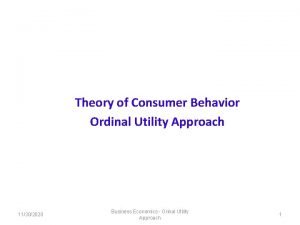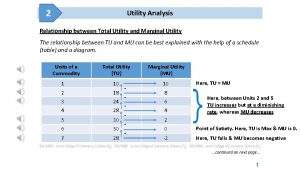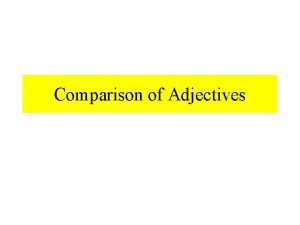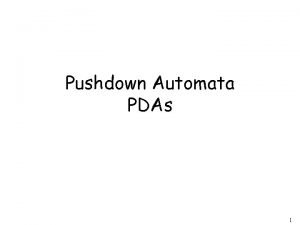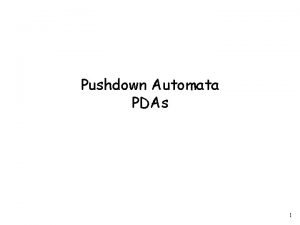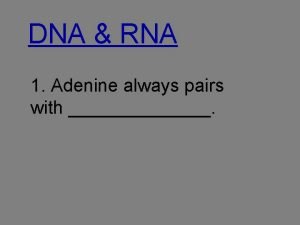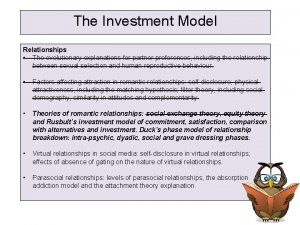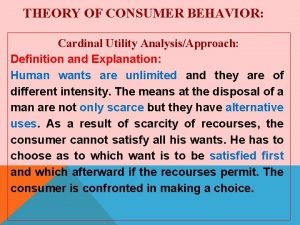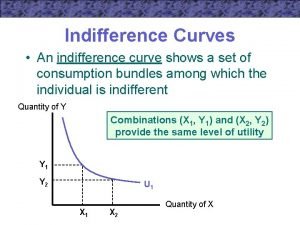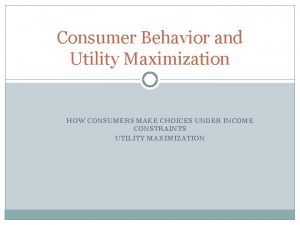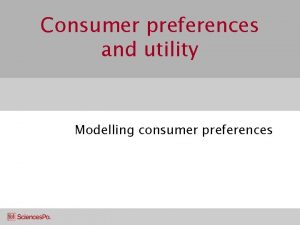Chapter Four Utility Preferences A Reminder p ux










































































- Slides: 74

Chapter Four Utility

Preferences - A Reminder p ux y: x is preferred strictly to y. u x ~ y: x and y are equally preferred. u x fy: x is preferred at least as ~ much as is y.

Preferences - A Reminder u Completeness: For any two bundles x and y it is always possible to state either that x fy ~ or that y fx. ~

Preferences - A Reminder u Reflexivity: Any bundle x is always at least as preferred as itself; i. e. x f x. ~

Preferences - A Reminder u Transitivity: If x is at least as preferred as y, and y is at least as preferred as z, then x is at least as preferred as z; i. e. x f y and y fz ~ ~ x f z. ~

Utility Functions u. A preference relation that is complete, reflexive, transitive and continuous can be represented by a continuous utility function. u Continuity means that small changes to a consumption bundle cause only small changes to the preference level.

Utility Functions u. A utility function U(x) represents a preference relation f ~ if and only if: p x’ x” U(x’) > U(x”) x’ px” U(x’) < U(x”) x’ ~ x” U(x’) = U(x”).

Utility Functions u Utility is an ordinal (i. e. ordering) concept. u E. g. if U(x) = 6 and U(y) = 2 then bundle x is strictly preferred to bundle y. But x is not preferred three times as much as is y.

Utility Functions & Indiff. Curves u Consider the bundles (4, 1), (2, 3) and (2, 2). u Suppose (2, 3) (4, 1) ~ (2, 2). u Assign to these bundles any numbers that preserve the preference ordering; e. g. U(2, 3) = 6 > U(4, 1) = U(2, 2) = 4. u Call these numbers utility levels. p

Utility Functions & Indiff. Curves u An indifference curve contains equally preferred bundles. preference same utility level. u Therefore, all bundles in an indifference curve have the same utility level. u Equal

Utility Functions & Indiff. Curves u So the bundles (4, 1) and (2, 2) are in the indiff. curve with utility level U º 4 u But the bundle (2, 3) is in the indiff. curve with utility level U º 6. u On an indifference curve diagram, this preference information looks as follows:

Utility Functions & Indiff. Curves p x 2 (2, 3) (2, 2) ~ (4, 1) Uº 6 Uº 4 x 1

Utility Functions & Indiff. Curves u Another way to visualize this same information is to plot the utility level on a vertical axis.

Utility Functions & Indiff. Curves 3 D plot of consumption & utility levels for 3 bundles U(2, 3) = 6 Utility U(2, 2) = 4 U(4, 1) = 4 x 2 x 1

Utility Functions & Indiff. Curves u This 3 D visualization of preferences can be made more informative by adding into it the two indifference curves.

Utility Functions & Indiff. Curves Utility Uº 6 Uº 4 x 2 x 1 Higher indifference curves contain more preferred bundles.

Utility Functions & Indiff. Curves u Comparing more bundles will create a larger collection of all indifference curves and a better description of the consumer’s preferences.

Utility Functions & Indiff. Curves x 2 Uº 6 Uº 4 Uº 2 x 1

Utility Functions & Indiff. Curves u As before, this can be visualized in 3 D by plotting each indifference curve at the height of its utility index.

Utility Functions & Indiff. Curves Utility Uº 6 Uº 5 Uº 4 Uº 3 Uº 2 x 2 Uº 1 x 1

Utility Functions & Indiff. Curves u Comparing all possible consumption bundles gives the complete collection of the consumer’s indifference curves, each with its assigned utility level. u This complete collection of indifference curves completely represents the consumer’s preferences.

Utility Functions & Indiff. Curves x 2 x 1

Utility Functions & Indiff. Curves x 2 x 1

Utility Functions & Indiff. Curves x 2 x 1

Utility Functions & Indiff. Curves x 2 x 1

Utility Functions & Indiff. Curves x 2 x 1

Utility Functions & Indiff. Curves x 2 x 1

Utility Functions & Indiff. Curves x 1

Utility Functions & Indiff. Curves x 1

Utility Functions & Indiff. Curves x 1

Utility Functions & Indiff. Curves x 1

Utility Functions & Indiff. Curves x 1

Utility Functions & Indiff. Curves x 1

Utility Functions & Indiff. Curves x 1

Utility Functions & Indiff. Curves x 1

Utility Functions & Indiff. Curves x 1

Utility Functions & Indiff. Curves x 1

Utility Functions & Indiff. Curves u The collection of all indifference curves for a given preference relation is an indifference map. u An indifference map is equivalent to a utility function; each is the other.

Utility Functions u There is no unique utility function representation of a preference relation. u Suppose U(x 1, x 2) = x 1 x 2 represents a preference relation. u Again consider the bundles (4, 1), (2, 3) and (2, 2).

Utility Functions u U(x 1, x 2) = x 1 x 2, so U(2, 3) = 6 > U(4, 1) = U(2, 2) = 4; p that is, (2, 3) (4, 1) ~ (2, 2).

Utility Functions = x 1 x 2 u Define V = U 2. p u U(x 1, x 2) (2, 3) (4, 1) ~ (2, 2).

Utility Functions = x 1 x 2 (2, 3) (4, 1) ~ (2, 2). u Define V = U 2. u Then V(x 1, x 2) = x 12 x 22 and V(2, 3) = 36 > V(4, 1) = V(2, 2) = 16 so again (2, 3) (4, 1) ~ (2, 2). u V preserves the same order as U and so represents the same preferences. p u U(x 1, x 2) p

Utility Functions p u U(x 1, x 2) = x 1 x 2 (2, 3) u Define W = 2 U + 10. (4, 1) ~ (2, 2).

Utility Functions = x 1 x 2 (2, 3) (4, 1) ~ (2, 2). u Define W = 2 U + 10. u Then W(x 1, x 2) = 2 x 1 x 2+10 so W(2, 3) = 22 > W(4, 1) = W(2, 2) = 18. Again, (2, 3) (4, 1) ~ (2, 2). u W preserves the same order as U and V and so represents the same preferences. p u U(x 1, x 2) p

Utility Functions u If – U is a utility function that represents a preference relation f ~ and – f is a strictly increasing function, u then V = f(U) is also a utility function representing f. ~

Goods, Bads and Neutrals u. A good is a commodity unit which increases utility (gives a more preferred bundle). u A bad is a commodity unit which decreases utility (gives a less preferred bundle). u A neutral is a commodity unit which does not change utility (gives an equally preferred bundle).

Goods, Bads and Neutrals Utility Units of water are goods x’ Utility function Units of water are bads Water Around x’ units, a little extra water is a neutral.

Some Other Utility Functions and Their Indifference Curves u Instead of U(x 1, x 2) = x 1 x 2 consider V(x 1, x 2) = x 1 + x 2. What do the indifference curves for this “perfect substitution” utility function look like?

Perfect Substitution Indifference Curves x 2 x 1 + x 2 = 5 13 x 1 + x 2 = 9 9 x 1 + x 2 = 13 5 V(x 1, x 2) = x 1 + x 2. 5 9 13 x 1

Perfect Substitution Indifference Curves x 2 x 1 + x 2 = 5 13 x 1 + x 2 = 9 9 x 1 + x 2 = 13 5 V(x 1, x 2) = x 1 + x 2. 5 9 13 x 1 All are linear and parallel.

Some Other Utility Functions and Their Indifference Curves u Instead of U(x 1, x 2) = x 1 x 2 or V(x 1, x 2) = x 1 + x 2, consider W(x 1, x 2) = min{x 1, x 2}. What do the indifference curves for this “perfect complementarity” utility function look like?

x 2 Perfect Complementarity Indifference Curves 45 o W(x 1, x 2) = min{x 1, x 2} = 8 8 min{x 1, x 2} = 5 min{x 1, x 2} = 3 5 3 3 5 8 x 1

x 2 8 5 3 Perfect Complementarity Indifference Curves 45 o W(x 1, x 2) = min{x 1, x 2} = 8 min{x 1, x 2} = 5 min{x 1, x 2} = 3 3 5 8 x 1 All are right-angled with vertices on a ray from the origin.

Some Other Utility Functions and Their Indifference Curves u. A utility function of the form U(x 1, x 2) = f(x 1) + x 2 is linear in just x 2 and is called quasilinear. u E. g. U(x 1, x 2) = 2 x 11/2 + x 2.

Quasi-linear Indifference Curves x 2 Each curve is a vertically shifted copy of the others. x 1

Some Other Utility Functions and Their Indifference Curves u Any utility function of the form U(x 1, x 2) = x 1 a x 2 b with a > 0 and b > 0 is called a Cobb. Douglas utility function. u E. g. U(x 1, x 2) = x 11/2 x 21/2 (a = b = 1/2) V(x 1, x 2) = x 1 x 23 (a = 1, b = 3)

Cobb-Douglas Indifference x 2 Curves All curves are hyperbolic, asymptoting to, but never touching any axis. x 1

Marginal Utilities u Marginal means “incremental”. u The marginal utility of commodity i is the rate-of-change of total utility as the quantity of commodity i consumed changes; i. e.

Marginal Utilities u E. g. if U(x 1, x 2) = x 11/2 x 22 then

Marginal Utilities u E. g. if U(x 1, x 2) = x 11/2 x 22 then

Marginal Utilities u E. g. if U(x 1, x 2) = x 11/2 x 22 then

Marginal Utilities u E. g. if U(x 1, x 2) = x 11/2 x 22 then

Marginal Utilities u So, if U(x 1, x 2) = x 11/2 x 22 then

Marginal Utilities and Marginal Rates-of-Substitution u The general equation for an indifference curve is U(x 1, x 2) º k, a constant. Totally differentiating this identity gives

Marginal Utilities and Marginal Rates-of-Substitution rearranged is

Marginal Utilities and Marginal Rates-of-Substitution And rearranged is This is the MRS.

Marg. Utilities & Marg. Rates-of. Substitution; An example u Suppose so U(x 1, x 2) = x 1 x 2. Then

Marg. Utilities & Marg. Rates-of. Substitution; An example U(x 1, x 2) = x 1 x 2; x 2 8 MRS(1, 8) = - 8/1 = -8 MRS(6, 6) = - 6/6 = -1. 6 U = 36 1 6 U=8 x 1

Marg. Rates-of-Substitution for Quasi-linear Utility Functions u. A quasi-linear utility function is of the form U(x 1, x 2) = f(x 1) + x 2. so

Marg. Rates-of-Substitution for Quasi-linear Utility Functions = - f ¢ (x 1) does not depend upon x 2 so the slope of indifference curves for a quasi-linear utility function is constant along any line for which x 1 is constant. What does that make the indifference map for a quasi-linear utility function look like? u MRS

x 2 Marg. Rates-of-Substitution for Quasi-linear Utility Functions MRS = - f(x 1’) Each curve is a vertically shifted copy of the others. MRS = -f(x 1”) MRS is a constant along any line for which x 1 is constant. x 1’ x 1” x 1

Monotonic Transformations & Marginal Rates-of-Substitution u Applying a monotonic transformation to a utility function representing a preference relation simply creates another utility function representing the same preference relation. u What happens to marginal rates-ofsubstitution when a monotonic transformation is applied?

Monotonic Transformations & Marginal Rates-of-Substitution u For U(x 1, x 2) = x 1 x 2 the MRS = - x 2/x 1. u Create V = U 2; i. e. V(x 1, x 2) = x 12 x 22. What is the MRS for V? which is the same as the MRS for U.

Monotonic Transformations & Marginal Rates-of-Substitution u More generally, if V = f(U) where f is a strictly increasing function, then So MRS is unchanged by a positive monotonic transformation.
 Ordinal utility
Ordinal utility Relation between marginal utility and total utility
Relation between marginal utility and total utility Cohesive essay
Cohesive essay Stir you up by way of reminder
Stir you up by way of reminder Proactive patient outreach
Proactive patient outreach Advertising mean
Advertising mean I693 reminder letter
I693 reminder letter Crumpled reminder activity
Crumpled reminder activity Binder reminder
Binder reminder Critical reminder
Critical reminder Adjectives for reminder
Adjectives for reminder Computation symbols
Computation symbols Input string
Input string Pda reminder 1
Pda reminder 1 Pda reminder 1
Pda reminder 1 Adenine always pairs with
Adenine always pairs with Thanks for the reminder.
Thanks for the reminder. Sql reminder
Sql reminder Fanny girden
Fanny girden Four types of utility marketing
Four types of utility marketing Past of wish
Past of wish What is claim of policy
What is claim of policy Elders housing preferences reflect a strong desire for
Elders housing preferences reflect a strong desire for Platform for privacy preferences project
Platform for privacy preferences project Gsp wto
Gsp wto Career choices and preferences in hrm
Career choices and preferences in hrm Tisc preferences
Tisc preferences Investment model of relationships
Investment model of relationships Well behaved preferences
Well behaved preferences Mendeley desktop preferences
Mendeley desktop preferences Icwa placement preferences
Icwa placement preferences Well-behaved preferences are
Well-behaved preferences are Seas application impact statement example
Seas application impact statement example How do you save panel locations and visibility preferences?
How do you save panel locations and visibility preferences? Flight preferences
Flight preferences Guest room preferences
Guest room preferences Rfc4191
Rfc4191 Thpes of learning
Thpes of learning A shape with four straight sides
A shape with four straight sides Skin assessment charting
Skin assessment charting Utility work zone traffic control
Utility work zone traffic control Precast communications vaults
Precast communications vaults Brogden-cronbach-gleser formula
Brogden-cronbach-gleser formula Berkeley utility locators
Berkeley utility locators Utility coordination
Utility coordination Utility cart definition
Utility cart definition Troy check printing software
Troy check printing software Infor eam upload utility
Infor eam upload utility Law of equi marginal utility
Law of equi marginal utility Form utility
Form utility Steven memberg
Steven memberg Capital allocation to risky assets
Capital allocation to risky assets Diminishing marginal utility
Diminishing marginal utility Operating system and utility are
Operating system and utility are Derivation of demand curve from marginal utility
Derivation of demand curve from marginal utility Form utility marketing
Form utility marketing Example of information utility
Example of information utility Marketing essentials chapter 1
Marketing essentials chapter 1 Utility communications market analysis
Utility communications market analysis Differentiate between compression and defragmentation
Differentiate between compression and defragmentation Introduction to business definition
Introduction to business definition Artificial probing chapter 2
Artificial probing chapter 2 Slope of an indifference curve
Slope of an indifference curve Transition analysis in hrm
Transition analysis in hrm Social utility connects
Social utility connects Pueblo of acoma utility authority
Pueblo of acoma utility authority Place utility examples
Place utility examples Utility network
Utility network Mouth temperature waxes
Mouth temperature waxes Theory of utility
Theory of utility Utility financial solutions
Utility financial solutions Utility maximizing rule example
Utility maximizing rule example Principle of utility john stuart mill
Principle of utility john stuart mill Equalizing marginal utility per dollar
Equalizing marginal utility per dollar What are utility programs in computer
What are utility programs in computer
